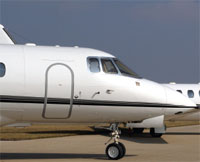The Canadian Air Transport Security Authority (CATSA) has awarded Unisys Canada Inc. a contract to supply, integrate and manage a new identification management system, using fingerprint and iris biometric technology to verify the identities of airport workers at 29 airports throughout Canada.
Syagen Technology Inc. conducted a trial deployment of its Guardian Explosives Trace Portal system, in collaboration with the John Wayne, Orange County Airport in California.
ESP Group and ObjectVideo recently announced the companies have partnered to provide a complete video surveillance system with embedded video content analysis to 40 Norwegian airports.

The inconveniences— and absurdities—that travelers face just to get through that checkpoint line seem to increase each year.
- By Megan Weadock
- May 01, 2008

Since Sept. 11, 2001, our nation has been obsessed with air-travel security. Terrorist attacks from the air have been the threat that looms largest in Americans’ minds. As a result, we’ve wasted millions on misguided programs to separate the regular travelers from the suspected terrorists—money that could have been spent to actually make us safer.
- By Bruce Schneier
- May 01, 2008
The Department of Homeland Security recently announced improvements aimed at strengthening aviation security while decreasing the hassle factor for travelers.
Smiths Detection, part of the global technology business Smiths Group, recently announced the first deployment of its Advanced Technology (AT) X-ray systems in the United States.
There’s safety (and security) in numbers -- especially when those numbers are random. That’s the lesson learned from a DHS-sponsored research project out of the University of Southern California. The research is already helping to beef up security at LAX airport in Los Angeles, and it could soon be used across the country to predict and minimize risk.
Before Sept. 11, 2001, perimeter security provided an extra barrier of protection for an airport and its people—typically from hijackers and vandals. Although that is still true, there is now an added threat. Today, we cannot afford to let a terrorist or attacker get near airport facilities, people or passengers. In all too many cases, getting close is all they have to do.
GE Security Inc. and Moscow International Airport Domodedovo recently announced GE’s Homeland Protection business has been chosen to provide two integrated advanced technology CTX 9000 DSi/XRD 3500 system-of-systems explosives detection solutions to the airport.
One of the first reactionary attempts to bolster security after 9/11 occurred at airports. Immediately after air service was reinstated, the public saw uniformed Marines armed with M-16s at every security checkpoint, concrete barriers at each entry point, security guards ransacking passengers’ luggage and, of course, taller fences going up around airfield perimeters. As with most things in life, an unexpected event usually generates an unexpected— and sometimes irrational— response. Such was the case with the nation’s aviation facilities.
- By Barry Willingham
- Mar 03, 2008
The last thing you want to find out while flying from one city to another is that airport security has been compromised. With so many people choosing flights as a preferred mode of transportation, airport security is paramount.
- By Ralph C. Jensen
- Jan 03, 2008

Today’s airports are at the frontline of homeland security. Checking for shoe bombs, banned liquids and suspected terrorists are part of the daily routine for airport security personnel. In fact, airport vulnerability has become such an issue that the Department of Homeland Security assigns the airline industry its own threat level designation. For example, airports can be assigned to threat level orange, meaning “High Risk of Terrorist Attacks” while the rest of the nation is at yellow, or “Elevated Risk.”